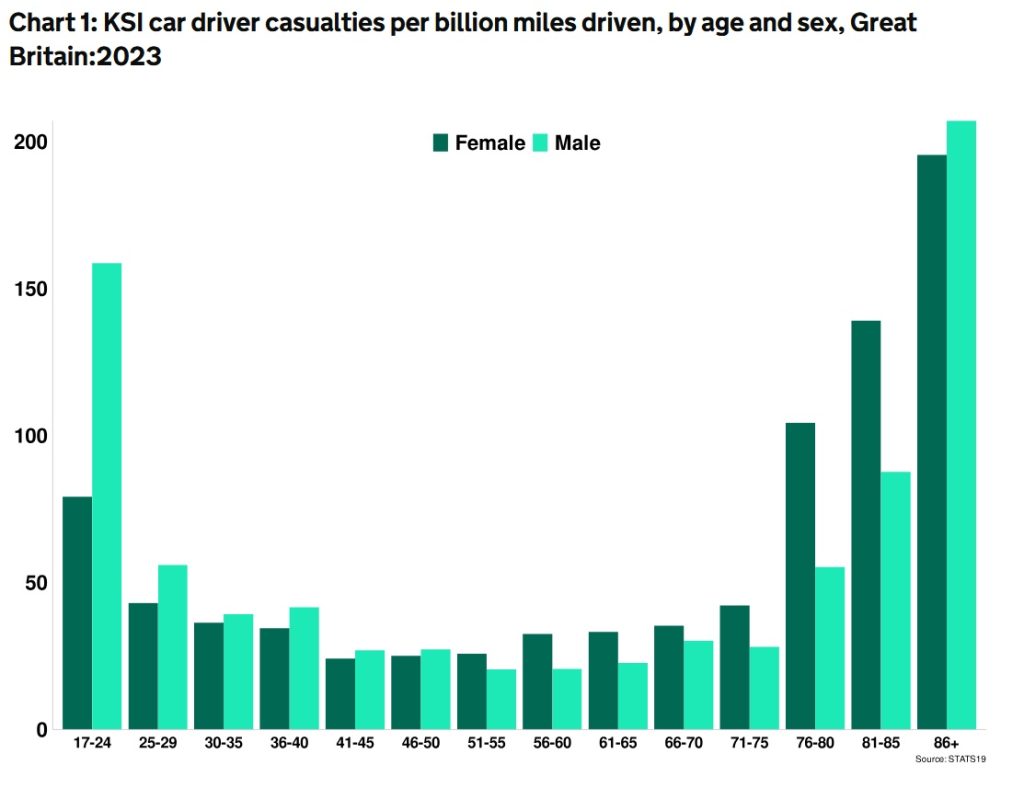
Is it open season on drivers over 60 at the moment? There’s the research study into standardised assessments for ‘mature’ drivers, slated to run until 2027. There’s the increasing number of reports submitted to the DVLA about older drivers. And a recent survey found 80% of drivers were in favour of voluntary driving tests for the over-60s.
Not surprisingly, news sites make the most of covering this. With 55% of newspaper subscribers now aged over 50, rage-and-fear-baiting of an older demographic is great for business. And as the comments sections demonstrate, those readers have no doubt that it’s not oldies who pose the greatest risk behind the wheel… it’s younger drivers!
So, are Gen Z worse drivers than their grandparents? Or vice versa? Let’s take a look.
The problem with individual cases
When it comes to safe driving, we can always find individual cases to back up our opinions, or maybe our prejudices.
If you believe that older drivers are a danger to other road users, there are no shortage of tragic news stories to back you up. Take the case of Jim Tassell, for example, a cyclist who was struck and killed by an elderly driver. In court, it emerged that the 82-year-old could only read a car number plate from 10 feet away.
On the other hand, if you think that young drivers are greater menaces, you can find plenty of incidents to reinforce that view. We won’t labour the point by linking to another news item.
Individual cases therefore tell us very little. The only way to really shed some light is to look at the bigger picture – and that means digging out some statistics.
What the numbers show – young drivers.
After a bit of hunting, the most useful sets of stats we found were the Government’s fact sheets on younger drivers.
These define younger drivers as those aged between 17 and 24, and they refer a lot to KSI, a grim little acronym which stands for Killed or Seriously Injured.
To give us a feel for the numbers, bear in mind that about 7% of the UK’s licence holders are younger drivers. So, if young people drive as safely as the licensed population as a whole, we’d expect to see them making up 7% of all the accident stats. Anything lower than 7% means their safety record is better, anything higher is worse.
With that in mind, here are some take-home stats about the UK’s younger drivers.
- About 18% of all road collisions that cause any sort of injury involve young drivers. We make that 257% higher than would be expected, based on the proportion of younger drivers on the road.
- About 20% of all KSI road collisions involve a young driver. That’s nearly three times higher than the figure we might expect.
- For collisions causing slight injuries, young drivers are involved in about 21% of cases – again, about three times higher than the expected figure.
- The KSI casualties per miles driven are also higher than for any other age group, apart from those aged over 86.
- Compared to drivers of other ages, the factors that contribute more to young drivers’ accidents are: driving carelessly, recklessly, or in a hurry; loss of control; travelling too fast; lack of experience.
What the numbers show – older drivers
Again, the most direct and useful source of information was the Government’s fact sheet on older drivers. The Government defines an older driver as someone aged 70 or above. About 14% of UK licence holders are over 70 – a number that’s increased rapidly over recent years.
The same logic applies as for young drivers. If older people on average drive as safely as the licensed population as a whole, we’d expect to see them making up 14% of all the accident stats.
This fact sheet has fewer points that we can extract, but here goes:
- About 9% of all road collisions causing injury involve an older driver. We make this 35% lower than the number of incidents you’d expect, based on the number of older licence holders.
- About 16% of all KSI road collisions involve an older driver. We make this about 14% more than would be expected .
- 8% of collisions that involve slight injury involve older drivers. This is 43% lower than we might expect based on the numbers of older drivers.
- In terms of per KSI collisions per miles driven, the precise numbers are hard to see in the form they’re presented, but we can see that older people seem to have more serious collisions per mile after the age of 75, with older women faring worse than men.
- Compared to drivers of other ages, the factors that contribute more to older drivers’ accidents are: failing to look properly, illness or disability, failure to judge other person’s path or speed.
Comparing younger vs older
It’s pretty clear that, statistically speaking, young drivers are involved in more accidents than older ones.
In fact the difference is pretty stark. If we adjust for the number of each age group on the road (and assuming our maths is right), we reckon that:
- a young driver is 2.5 times more likely than an older one to be involved in a serious collision.
- a young driver is five times more likely than an older one to be involved in a minor collision.
One reason for this is simply that young people are out and about more. Older drivers typically drive fewer miles. Older people are also more cautious about where they drive, sticking to more familiar routes and areas.
On an accident-per-mile basis, the difference is less clear cut. Both younger and older drivers do worse than average, and the very oldest drivers are involved in more serious incidents than their young counterparts. However, again, we need to bear in mind that very elderly drivers tend to be less robust and are more easily injured.
Getting things in proportion
Take a look at this graph of KSI injuries by age group. It’s from the second government fact sheet cited above.

What struck us about looking at this is just how incredibly rare serious accidents are. The graph is measured in terms of billions of miles driven.
That means that on average, a driver in the most incident-prone group – men over 86 – would have to drive 5 million miles before being involved in a serious accident, or about 500 years of typical road use.
Of course, that doesn’t mean we shouldn’t shoot for better safety, but we hope it helps keeps things in proportion.
Avoid the clichés
This relative rarity of road accidents tell us something important: the vast majority of drivers of all age groups are safe and competent. You may not always feel like that on your daily commute, but that’s because we pay more attention to the handfuls of bad drivers we encounter, rather than the thousands of good ones.
And so, if you stereotype younger drivers as speeding hooligans with one eye on the road and one on their iPhone, you’re simply wrong. Most of them aren’t like that at all. And you’re equally wrong if you characterise older drivers as half-blind ditherers who shouldn’t be on the road.
Almost all of both groups are doing just fine.
The WVS blog covers a wide range of automotive topics, from the contentious to the light-hearted. We are an independent garage specialising in all the VW group marques, including Audi, Volkswagen, Skoda and SEAT. WVS provides services, repairs and MOTs, delivering a main dealer level of care at affordable prices. To book your vehicle in, or for any enquiries, get in touch.
